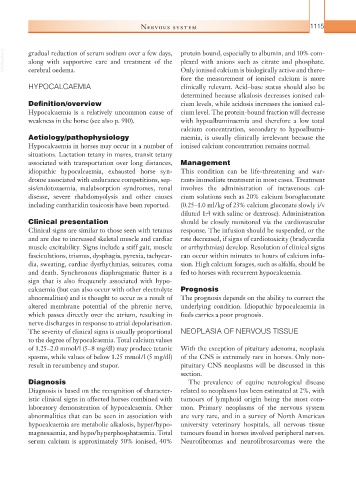Page 1140 - Equine Clinical Medicine, Surgery and Reproduction, 2nd Edition
P. 1140
Nervous system 1115
VetBooks.ir gradual reduction of serum sodium over a few days, protein bound, especially to albumin, and 10% com-
plexed with anions such as citrate and phosphate.
along with supportive care and treatment of the
Only ionised calcium is biologically active and there-
cerebral oedema.
fore the measurement of ionised calcium is more
HYPOCALCAEMIA clinically relevant. Acid–base status should also be
determined because alkalosis decreases ionised cal-
Definition/overview cium levels, while acidosis increases the ionised cal-
Hypocalcaemia is a relatively uncommon cause of cium level. The protein-bound fraction will decrease
weakness in the horse (see also p. 910). with hypoalbuminaemia and therefore a low total
calcium concentration, secondary to hypoalbumi-
Aetiology/pathophysiology naemia, is usually clinically irrelevant because the
Hypocalcaemia in horses may occur in a number of ionised calcium concentration remains normal.
situations. Lactation tetany in mares, transit tetany
associated with transportation over long distances, Management
idiopathic hypocalcaemia, exhausted horse syn- This condition can be life-threatening and war-
drome associated with endurance competitions, sep- rants immediate treatment in most cases. Treatment
sis/endotoxaemia, malabsorption syndromes, renal involves the administration of intravenous cal-
disease, severe rhabdomyolysis and other causes cium solutions such as 20% calcium borogluconate
including cantharidin toxicosis have been reported. (0.25–1.0 ml/kg of 23% calcium gluconate slowly i/v
diluted 1:4 with saline or dextrose). Administration
Clinical presentation should be closely monitored via the cardiovascular
Clinical signs are similar to those seen with tetanus response. The infusion should be suspended, or the
and are due to increased skeletal muscle and cardiac rate decreased, if signs of cardiotoxicity (bradycardia
muscle excitability. Signs include a stiff gait, muscle or arrhythmias) develop. Resolution of clinical signs
fasciculations, trismus, dysphagia, pyrexia, tachycar- can occur within minutes to hours of calcium infu-
dia, sweating, cardiac dysrhythmias, seizures, coma sion. High calcium forages, such as alfalfa, should be
and death. Synchronous diaphragmatic flutter is a fed to horses with recurrent hypocalcaemia.
sign that is also frequently associated with hypo-
calcaemia (but can also occur with other electrolyte Prognosis
abnormalities) and is thought to occur as a result of The prognosis depends on the ability to correct the
altered membrane potential of the phrenic nerve, underlying condition. Idiopathic hypocalcaemia in
which passes directly over the atrium, resulting in foals carries a poor prognosis.
nerve discharges in response to atrial depolarisation.
The severity of clinical signs is usually proportional NEOPLASIA OF NERVOUS TISSUE
to the degree of hypocalcaemia. Total calcium values
of 1.25–2.0 mmol/l (5–8 mg/dl) may produce tetanic With the exception of pituitary adenoma, neoplasia
spasms, while values of below 1.25 mmol/l (5 mg/dl) of the CNS is extremely rare in horses. Only non-
result in recumbency and stupor. pituitary CNS neoplasms will be discussed in this
section.
Diagnosis The prevalence of equine neurological disease
Diagnosis is based on the recognition of character- related to neoplasms has been estimated at 2%, with
istic clinical signs in affected horses combined with tumours of lymphoid origin being the most com-
laboratory demonstration of hypocalcaemia. Other mon. Primary neoplasms of the nervous system
abnormalities that can be seen in association with are very rare, and in a survey of North American
hypocalcaemia are metabolic alkalosis, hyper/hypo- university veterinary hospitals, all nervous tissue
magnesaemia, and hypo/hyperphosphataemia. Total tumours found in horses involved peripheral nerves.
serum calcium is approximately 50% ionised, 40% Neurofibromas and neurofibrosarcomas were the

